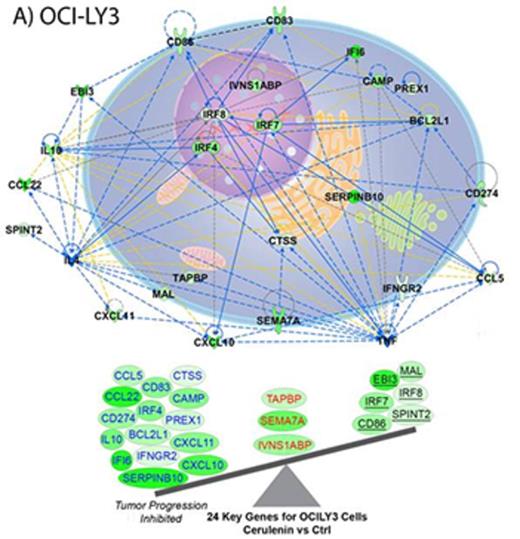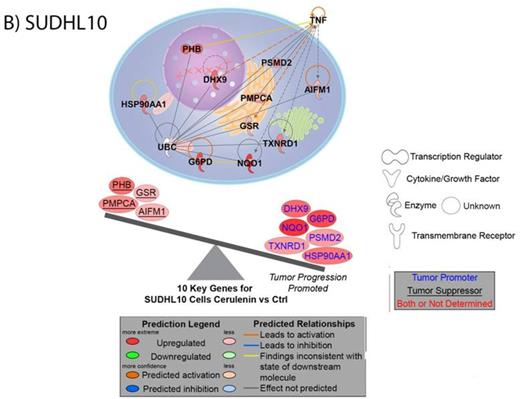Abstract
Introduction: Fatty acid (FA) metabolism is altered in many solid tumor cancers in part through increased de novo synthesis of lipids via up-regulation of FASN as well as via increased utilization of lipids via β-oxidation. The dependence of DLBCL on FA metabolism, and potential associated oncogenic signaling pathways, are largely unknown.
Methods: Cerulenin (FASN inhibitor), orlistat (combined FASN and lipoprotein lipase inhibitor), and BKM120 (PI3K inhibitor) small molecules were studied in OCI-LY3, OCI-LY19, SUDHL4, SUDHL6, and SUDHL10 DLBCL cell lines as well as in primary DLBCL cells for the impact on FA inhibition signaling and the induction of cell death (by MTT, cleaved caspases, and AnnexinV/PI by flow cytometric analysis). Synergy was assessed via Calcusyn software. All effects were compared by DLBCL cell of origin (COO). In addition, global transcriptome analyses of FASN inhibition were examined on Affymetrix Human 2.0 ST Genechip.
Results: FASN protein was constitutively upregulated across all DLBCL cell lines, independent of COO. Treatment with pharmacological inhibitors of FASN (i.e., cerulenin or orlistat) resulted in dose- and time-dependent reduction in cell viability in all DLBCL cell lines. To further examine the dependence of DLBCL on fatty acids, OCI-LY3, SUDHL4, and SUDHL6 grown in presence of lipoprotein-depleted serum showed exquisite sensitivity to lipid deprivation resulting in near complete cytotoxicity (i.e., >98%) as determined by MTT, cleaved caspase 3 and PARP, and AnnexinV/PI. Moreover, these effects were completely rescued by Very Low Density Lipoprotein (VLDL) supplementation to growth medium. These effects were markedly more prominent in primary DLBCL cells compared with control non-malignant lymphocytes. Analysis of differentially expressed gene sets comparing germinal center (GC) and non-germinal center (non-GC) B-cell tumors with normal cells showed significant over expression of genes related to PI3K and lipid metabolism in GC B-cell tumors. Furthermore, global transcriptome analysis following cerulenin exposure revealed activation of carbohydrate and oxidative stress metabolism in GC-derived SUDHL6 and SUDHL10 cells. In the non-GC cell line, OCI-LY3, there was favorable biology induced with inhibition of progression when treated with cerulenin, with downregulated significant key genes representing growth promoting cytokines (Figure 1). Analysis of key significant genes in cerulenin-treated SUDHL10 cells resulted in induction of antioxidant genes (GSR, TXNRD1, NQO1, AIFM1) and oxidative stress responsive PHB, DHX9, HSP90 and PMPCA genes, which are upstream components of PI3K signaling. Western blot analysis with prohibitin (PHB) inhibitor rocoglamide in the presence of cerulenin inhibited phosphorylation of PI3K-p85 and also prominently downregulated FASN expression of GC-derived DLBCL, suggesting the role of PHB in PI3K response to cerulenin. In addition, inhibition of PI3K with BKM120 was shown to strongly down-regulate FASN expression in OCI-LY3, SUDHL6, and SUDHL10 DLBCL cells. Furthermore, treatment with BKM120 in combination with cerulenin was strongly synergistic (CI<1), by MTT and potentiated apoptosis (by Annexin/V flow cytometry) in GC-derived SUDHL10 cells.
Conclusions: Multiple FA pathways are constitutively activated in DLBCL and cell survival appears strongly dependent on lipid metabolism, which appeared to occur independent of COO. Additionally, inhibition of FASN was regulated in part through PHB/PI3K-dependent pathways. Collectively, this work indicates that targeting FA metabolism may be considered as a valid therapeutic strategy for DLBCL. Further investigation is required to delineate the precise mechanisms through which PHB/PI3K regulates FASN and also to identify potential rational therapeutic combinations leveraging the addiction of DLBCL to FA signaling.
Key significant gene analysis ofFASN inhibition inDLBCL cells. Cerulenin treatment in ABC OCI-LY3 shows (A) downregulation of growth promoting cytokines and growth factors and favorable tumor biology with predicted inhibition of tumor progression. In the GC derived SUDHL10 cells, (B) cerulenin resulted in activation of genes associated with oxidative stress response and PI3K associated mitochondrial genes with adverse tumor biology predicting tumor progression in GC DLBCL.
Key significant gene analysis ofFASN inhibition inDLBCL cells. Cerulenin treatment in ABC OCI-LY3 shows (A) downregulation of growth promoting cytokines and growth factors and favorable tumor biology with predicted inhibition of tumor progression. In the GC derived SUDHL10 cells, (B) cerulenin resulted in activation of genes associated with oxidative stress response and PI3K associated mitochondrial genes with adverse tumor biology predicting tumor progression in GC DLBCL.
No relevant conflicts of interest to declare.
Author notes
Asterisk with author names denotes non-ASH members.



This feature is available to Subscribers Only
Sign In or Create an Account Close Modal